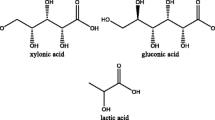Abstract
Potentiometry and spectrophotometry are the most frequently used experimental methods to study equilibrium systems in solutions; these methods may be used in many different types of experimental arrangements. The equilibrium system can be described through the mass-balance equations as
where n is the number of species in the system, including the components; S j is the jth species present in the system; k is the number of components in the system; [c1] ... [c k ] is the equilibrium (free) concentration of the components; \( {\beta _j} = \left[ {{S_j}} \right]/\left( {\prod\nolimits_{i = 1}^k {{{\left[ {{c_i}} \right]}^{\alpha ji}}} } \right) \), the formation constant of the species, (the formation constants of the components are unity); α ji are stoichiometric numbers, giving the number of the ith component in the jth species.
Access this chapter
Tax calculation will be finalised at checkout
Purchases are for personal use only
Preview
Unable to display preview. Download preview PDF.
Similar content being viewed by others
References
G. E. Forsythe and C. B. Moler, Computer Solution of Linear Algebraic Systems, Prentice-Hall, Englewood Cliffs, New Jersey [Hungarian translation, Müszaki Könyvkiadö, Budapest, (1976)].
W. R. Smith, The Computation of Chemical Equilibria in Complex System, Ind. Eng. Chem. Fundam. 19, 1–10 (1980).
A. A. Bugaevsky and B. A. Dunai, Calculation of the Equilibrium Composition and Buffer Properties of Solutions with the Use of Computers (in Russian), Zh. Anal. Khim. 26, 205–209 (1971).
A. A. Bugaevsky, L. E. Rudnaya, and T. P. Mukhina, Calculation of Equilibria in Complex Systems (in Russian), Zh. Anal. Khim. 27, 1675–1679 (1972).
A. A. Bugaevsky and L. E. Nikishina, On the Analytical Method of Calculating the Derivatives of Equilibrium Concentrations, Talanta 28, 977 (1981).
I. Nagypál, I. Páka, and L. Zékány, Analytical Evaluation of the Derivatives Used in Equilibrium Calculations, Talanta 25, 549–550 (1978).
J. M. Ortega and W. C. Rheinboldt, Iterative Solution of Nonlinear Equations in Several Variables, Academic Press, New York (1970).
Yu. V. Linnik, Method of Least Squares and Principles of the Theory of Observations, Pergamon Press, Oxford (1961).
L. G. Sillén and B. Warnqvist, High-speed Computers as a Supplement to Graphical Methods. 6. A Strategy for Two-level LETAGROP Adjustment of Common and “Group” Parameters. Some features that avoid divergence. Ark. Kemi 31, 315–339 (1969).
R. H. Barham and W. Drane, An Algorithm for Least Squares Estimation of Nonlinear Parameters When Some of the Parameters are Linear, Technometrics 14, 757–766 (1972).
A. D. Zuberbuhler and Th. A. Kaden, TITFIT, A Comprehensive Program for Numerical Treatment of Potentiometric Data using Analytical Derivatives and Automatically Optimized Subroutines with the Gauss-Newton-Marquardt Algorithm, Talanta 29, 201–206 (1982).
A. Sabatini, A. Vacca, and P. Gans, MINIQUAD—A General Computer Programme for the Computation of Formation Constants from Potentiometric Data, Talanta 21, 53–77 (1974).
H. M. Irving, M. G. Miles, and L. D. Pettit, A Study of Some Problems in Determining the Stoicheiometric Proton Dissociation Constants of Complexes By Potentiometric Titrations Using a Glass Electrode, Anal. Chim. Acta 38, 475–488 (1967).
Author information
Authors and Affiliations
Editor information
Editors and Affiliations
Rights and permissions
Copyright information
© 1985 Plenum Press, New York
About this chapter
Cite this chapter
Zekany, L., Nagypal, I. (1985). PSEQUAD. In: Leggett, D.J. (eds) Computational Methods for the Determination of Formation Constants. Modern Inorganic Chemistry. Springer, Boston, MA. https://doi.org/10.1007/978-1-4684-4934-1_8
Download citation
DOI: https://doi.org/10.1007/978-1-4684-4934-1_8
Publisher Name: Springer, Boston, MA
Print ISBN: 978-1-4684-4936-5
Online ISBN: 978-1-4684-4934-1
eBook Packages: Springer Book Archive




